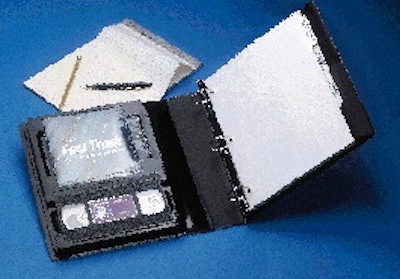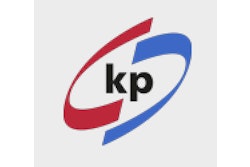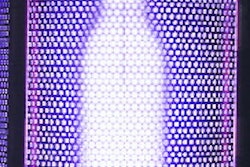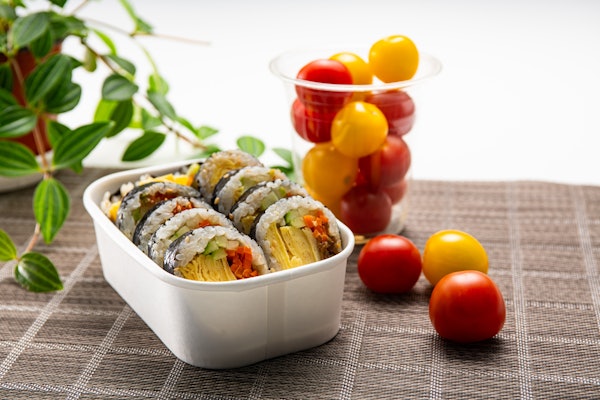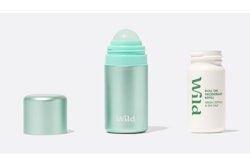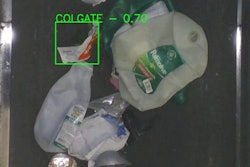When a consumer invests hundreds of dollars in a training program using audio cassettes, the expectation is that the tray holding those pricey cassettes will perform its sizable variety of duties. These include protection of the tape in shipment, ease of removal of the tape cassette, snap-fit security when the tape is returned to the tray and the appearance of an attractive carrier that can be used many times.
In addition, these trays often are required to display innovative "well" designs, unusual stair-stepped configurations to hold a variety of components. Sometimes the tray may need to use special closures like Velcro(TM), along with different colors and finishes that enhance the perception of the value of the contents. That's because the tray is not just a one-way carrier for the audio or visual product; often it's used repeatedly.
"Audio-visual packaging has grown remarkably with the new communications technologies that are now available," says Bob Stoltz, president of Vinylweld (Chicago, IL), a thermoformer of specialty trays. "As a result, learning systems, self-help programs for personal improvement, business training, organizers for workbooks, diet programs, brochures and other instructional materials have blossomed. Efficient use of these programs is vital to their success, and the trays that carry them can often make a big difference."
A subsidiary of Pen-Tab Industries, Inc., Vinylweld produces innovative trays for customers like Excel Communications, Nightingale-Conant and Talk America. The expectation of these companies for a consistent, high-quality tray is one reason the thermoformer has recently converted to a new polyvinyl chloride sheet, Pentaform® from Klockner Pentaplast of America (Gordonsville, VA).
"In vacuum forming of semi-rigid materials, you need a sheet that maintains as even a material distribution as possible," stresses Clarence Payne, vice president of manufacturing for Vinylweld. "The material from Klockner performs very well for us, especially in terms of uniform thickness across the web."
Trainer's notebook
Along with production of a complex tray configuration, Vinylweld often becomes involved with the design of the tray. One example is a tray for Excel's "Learning to Excel" notebook. The Fort Worth, TX-based firm is a telecommunications company, and the notebook is used by its trainers in the field. "We operate a multilevel marketing company for our telecommunications products," says Julie Melendi, manager of marketing communications productions for the company.
"When a person signs up to be an independent representative of Excel, part of the package is training by a certified Excel trainer," she says. "These trainers train the new representatives about the products, about marketing plans, about technical support--all the important functions these people will need to know. After all, we're the fourth-largest long-distance company in the U.S., and we have products like pagers as well as our services."
For this project, Melendi's task was to develop a packaging part that would hold a number of items of different sizes, from overhead projector transparencies to a flip chart, from a compact disc to a computer diskette. "These components and others all needed to be able to snap into a tray that would be part of the notebook. I explained these needs to Vinylweld, and it came up with a specific tray design. Originally, Vinylweld proposed a drawing to fit our needs, and later a prototype that worked perfectly."
Finished design
The design is a PVC tray that holds a videotape at the bottom, with other areas above it that allow a diskette, a 4"x6" flip chart and finally a CD-ROM disk on top.
"The tolerances have to be very precise, because we want the materials to be held securely for shipment," says Melendi. "But we also want the trainer to be able to quickly remove materials from the tray for use. It's vital that this teaching system works reliably as one complete, self-contained book that holds all the training materials. This is truly a unique package that has become a highly effective teaching system for our area coordinators to use."
Although the tray appears to be quite sophisticated, Melendi says there was relatively little development time involved, once Vinylweld produced a detailed drawing. "Almost no modifications were needed. The design process was pretty painless."
The shift to Klockner's Pentaform PVC sheet is just one reason the thermoformer has been able to meet its customer needs. "This growth in the audio-visual segment has brought greater pressure on us to provide packaging that works to the precision levels that this kind of product requires," says Vinylweld's Stoltz. "As a consequence, we elected to work with Klockner to obtain the critical gauge control required for these trays."
More uniform sheet helps the thermoformer in a variety of ways. "First off, we avoid waste in purchasing material," Stoltz says. "Although the gauges we use vary from 10 to 30 mils, when we need a 20-mil sheet to achieve critical functions in the resulting tray, we don't want to pay for 21-mil sheet. That's wasteful because it's more material than we need. Some suppliers produce thicknesses that vary, but we need to know exactly what we're getting. Klockner's sheet is right on spec."
Simple thermoforming process
Although almost every job is unique, the real work is done in the design of the part. By the time tooling is made and fit onto the thermoforming machine, any adjusting or modifying has already been completed in the prototype stage.
The company uses thermoformers from several manufacturers. But the process is virtually the same, no matter how complex the design. Sheet in rolls unwinds first into a heater section that softens it, then cycles it ahead into the molding station where the molds use heat and vacuum to form the trays from two- to eight-up across the web. Later, they're die-cut from the web and stacked.
For most of these audio-visual accounts, the trays are then moved to an assembly area where the trays are matched to the notebooks or other carriers and heat-sealed to them. Then they're shipped to the company that adds the media and packages them for shipment to their final customers.
Sometimes, these programs go into a briefcase design that organizes many components. Other times, the package is more complex. Vinylweld makes the trays that hold the King James version of the New Testament on 48 cassettes. For this application, padding, foil stamping and a three-dimensional molded design adds an attractive, traditional look to the presentation.
Other tray designs
Other trays are more straightforward and workmanlike. The albums for tapes by Nightingale-Conant are usually 12"x 9"x1", and shipped 25 per corrugated box. On receipt, Vinylweld's customer slides out the album, fills the trays with the educational materials and then ships out the programs to its customers.
Talk America, Portland, ME, uses a Vinylweld tray for its "Protein Power Plan." This tray design encloses four audio cassettes, a VHS video, a dietary supplement pill packet and a variety of literature. "We were looking for consistency and repeatability in performance for this package," says Eddy Pham, manager of vendor relations at Talk America. "We didn't have that in our tray before.
"So we went through three revisions and now have a display unit that works well. Once our customer opens it up, it lays out everything in the proper order a customer requires to follow the plan."
Other Vinylweld customers include speed reading programs like Evelyn Wood's "Reading Dynamics," general programs like Denis Waitley's "The Psychology of Winning," and Kevin Trudeau's "Mega Math."
Basic to all of these programs, says Stoltz, is a consistent, easy-to-use tray. Verifying this, Excel's Melendi says, "The production pieces were identical to the prototypes we tested. We've had a lot of positive response to the tray."
